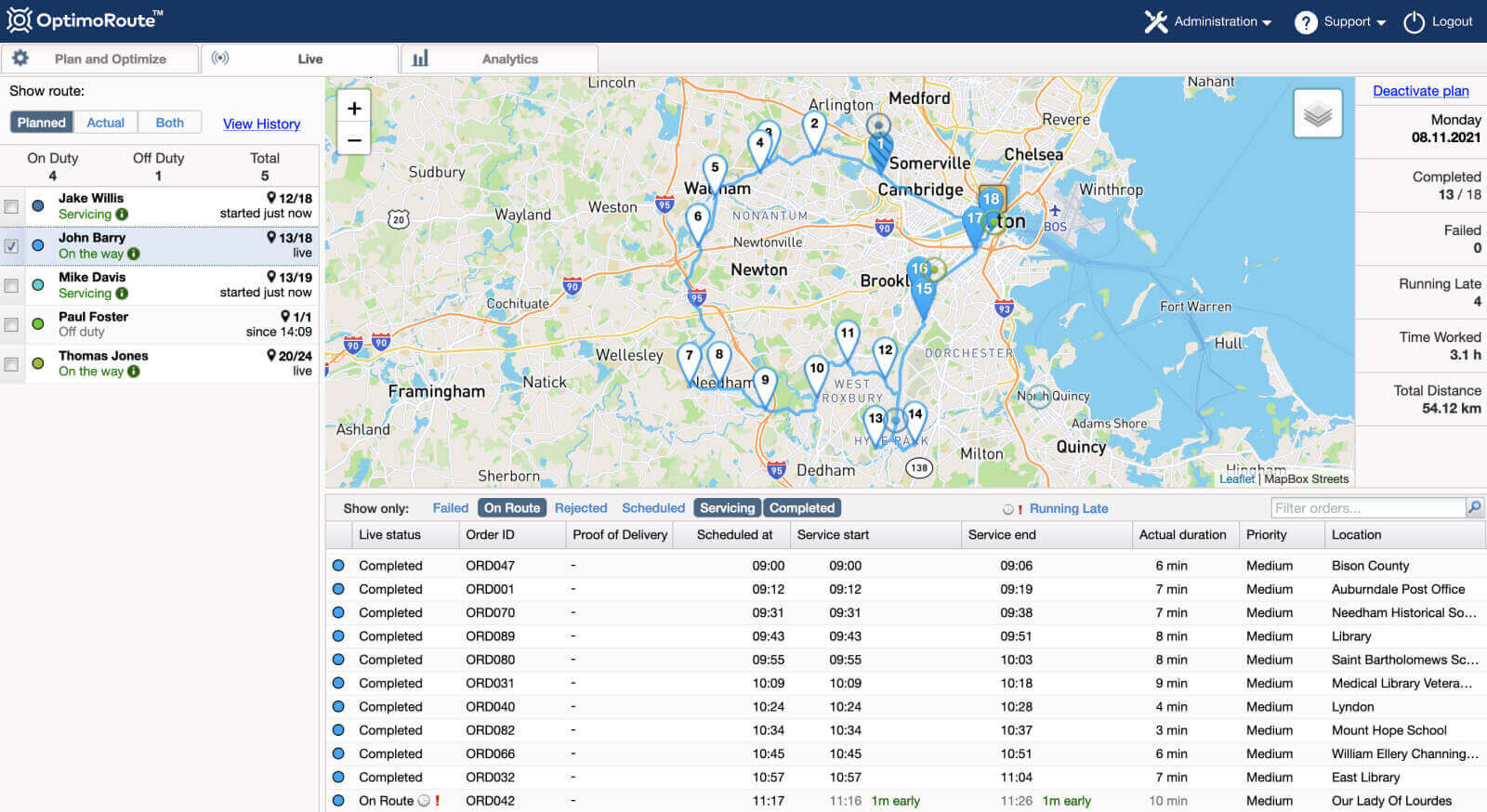How to Optimize Your Business for Seasonality
7 min read

There’s never a wrong time to satisfy your sweet tooth, but some times are better than others. Nearly half of all homes in the U.S. stock up on seasonal chocolates for the winter holiday season. However, when it comes time to trick-or-treat, only 25% of U.S. homes have chocolate on hand. To deal with these fluctuations in demand, the chocolate industry has to adjust operations to account for business seasonality.
One of the biggest challenges businesses face as a result of seasonal fluctuations is meeting the high demand during their industry’s peak season. Business owners can mitigate this challenge by calculating predicted demand and scaling operations accordingly.
Skip to the part that most interests you:
- What Is Business Seasonality?
- How to Calculate Seasonal Shifts in Demand
- 2 Strategies for Handling Seasonal Fluctuations
- Scale Your Operations Up and Down With Ease Using OptimoRoute
- FAQs About Business Seasonality
What Is Business Seasonality?
Business seasonality refers to the predictable ebbs and flows of consumer demand that result from seasonal changes. Those changes can include the literal change of season, or can refer more specifically to holidays like Easter or events like the Super Bowl. These fluctuations in business are driven by customer demand, like how gym memberships skyrocket in January, generating 12% of annual membership sales as individuals try to stick to their New Year’s resolutions.
During the off-season, these seasonal businesses may drastically scale back operations or even close down. A few other examples of seasonal businesses include travel planning organizations, landscaping companies, floral shops, and any other business that experiences drastic shifts in demand.
Historic demand and seasonal customer needs are the two biggest factors that inform seasonality. But depending on your specific business, there may be other factors that can also impact seasonal demand. For example, the seasonal demand for a pool maintenance business may be different in various regions due to weather patterns. As a result, the season for this type of service will be longer in warm and sunny states like California than it is in others like Michigan, where there are higher rates of pool ownership despite the winter months that bring freezing temperatures.
How to Calculate Seasonal Shifts in Demand
To calculate shifts in demand, you’ll need to look at data about your business’s sales. You must consistently analyze and compare sales data over multiple years. You can do this yourself manually or with an accounting solution. You may also choose to consult a financial advisor if you do not have the bandwidth or the skills for the level of data analysis your company requires.
Begin by collecting historical data about your organization’s order volume. The data you collect should span 12 months. Add all of the monthly orders to get a total for the calendar year. Then, divide each month’s sales by the annual total. This will show you how each month translates as a percentage of your annual sales. For example, if a gym records $20,000 in membership sales in January and the annual sales are $120,000, then January accounts for 16.7% of annual membership sales—twice what you would expect in a typical, non-seasonal business. The months with higher percentages are the months that there is higher demand, while those with lower percentages indicate slowdowns in demand.
You should conduct this process for at least two or three years of historical data. Looking at the data for one year will only provide you with information about that period and may be skewed due to factors other than seasonality, such as how toilet paper sales drastically increased in 2020 due to the coronavirus. Looking at data from multiple years will show you long-term trends that will be more reliable for forecasting. Look at percentage changes in order volume from each month and compare to data from prior years. Over time, this will provide you with a reliable source that indicates peak sales months, allowing you to see seasonal cycles and predict future sales fluctuations.
2 Strategies for Handling Seasonal Fluctuations
Seasonal fluctuations present challenges for businesses, including changing needs for staffing and managing inventory. Preparing with data and leveraging the right tools will help you respond to any challenges your business may face, even if you can’t anticipate what they will be.
Use data, so you know what to expect
Calculate seasonal shifts in demand at the end of every fiscal year. This will help provide you with an accurate record of your business’s order demand that you can use to forecast future demands. Once you know what to expect, you can plan for what you’ll need to meet demand.
Once you’ve looked at this data, begin building a plan that will meet your forecasted demand. Based on the percentage increase in sales, you can scale your operations up by the same percentage to ensure you aren’t severely overstaffing or dangerously low on stock to sell.
Harness technologies that can improve efficiency during the busy season
Software helps seasonal businesses by automating some of the more complicated aspects of the business, such as tracking inventory, routing trucks, and managing sales. This automation is key for business success during peak seasons as it helps to alleviate stress from managers, freeing them up to focus on key parts of the operation that can’t be automated.
Routing software
Routing software automates the process of scheduling and planning delivery and transport routes. This type of solution offers features like automated planning and route modification that help organizations respond to fluctuations in demand. This is particularly beneficial to seasonal businesses that rely on their own fleets for transportation and delivery that must adjust the size of the fleet to meet demand.
Route optimization is difficult when a massive influx of orders complicates planning for route managers. For example, while a floral shop may be able to keep up with its standard deliveries throughout the year, they will be burdened with high volumes of orders to fill on holidays like Valentine’s Day. A scalable routing solution alleviates this challenge by accommodating a larger fleet during peak sales times and downsizing to handle a smaller operation during the off-season.
Point of sale software
Seasonal businesses rely heavily on the profits they make during peak season to carry the business through the rest of the year. Implementing a point of sale software can help managers to track sales during the chaos of peak season and streamline accounting. Some point of sale systems also facilitate loyalty programs, which can help your business to retain customers who may otherwise forget about your business during the off-season. In fact, customers who participate in loyalty programs are 77% more likely to remain loyal to the business.
Inventory management software
Inventory management software is designed to help monitor inventory and ensure that businesses always have optimal levels of stock. Seasonal businesses have drastic fluctuations in inventory due to the changes in demand, which can be difficult to manage. Inventory management software helps businesses to account and prepare for these fluctuations by assessing historic data and forecasting for the future.
Scale Your Operations Up and Down With Ease Using OptimoRoute
Implementing OptimoRoute to optimize route planning helps businesses respond to seasonal changes in demand by allowing customers to expand their fleets, cut costs during the off-season, and account for varying levels of stock throughout the year.

Hire seasonal employees
When demand increases for your industry’s peak season, you’ll need to hire seasonal employees to meet that demand. You’ll need to bring them up to speed quickly, but this can be difficult as you will be onboarding them as your business ramps up for its busiest season. With OptimoRoute, hiring additional drivers and adding them to the software takes minutes. All they need is an email and a mobile device and they can start delivering in less than an hour using our Mobile App.
Cut expenses during the off-season
OptimoRoute also helps lower fuel costs by planning routes that cut down on drive time. Lowering costs when you’re able will provide you with a reserve of income that you can use to address future financial needs. One of the best ways to do this is by cutting transportation costs. Use the off-season to your advantage by planning for ways to cut costs so you’ll be ahead of the game when business picks up for peak season.
Save time on planning
OptimoRoute eliminates the stress of scaling during your busiest times of the year by automating the process. It may be manageable for small business owners to manually route one or two vehicles during the off months, but this will become impossible when demand forces you to scale. Implementing OptimoRoute ensures that route planning is always easy, no matter how busy your organization gets.
For example, Gallagher Pools a pool cleaning company in Maryland was struggling to balance workloads and manually plan routes during the busy summer months. By implementing OptimoRoute, the company was able to automatically plan balanced routes in half the amount of time.
Adjust back stock based on seasonal demand
As your orders increase during peak season, you’ll need to ensure you have the product to meet demand. This increase in orders will also translate to a comparable increase in stops on your routes to fulfill orders and complete deliveries. Workload balancing helps you account for these fluctuations in back stock by spreading the work evenly among your available staff, ensuring you don’t overburden any one employee.
Respond to drastic fluctuations in demand
When demand fluctuates, so will your business—and you need a solution that can scale with you. OptimoRoute offers flexible pricing, allowing you to leverage the benefits of automation during your busiest months and cut costs during the off-season.
For example, by implementing OptimoRoute, The Little Posy Co. was able to respond to a 500% increase in orders which resulted from the Valentine’s Day holiday. Flexible pricing allowed the company to scale its fleet for the holiday, then scale back down to meet standard demand.
To see how OptimoRoute can help your seasonal business mitigate the effects of seasonality and scale to meet demand, try our software free for 30 days!
FAQs About Business Seasonality
How do businesses deal with seasonality?
Businesses can respond to seasonality by scaling their operations up or down to match customer demand. For example, a clothing store may hire seasonal employees and increase back stock for busy holiday shopping periods, such as Black Friday.
What is an example of business seasonality?
One example of business seasonality is when gym memberships and self-help book sales dramatically increase as a result of New Year’s resolutions. Another example is back-to-school shopping, when customers stock up on new clothes and office supplies like pens and paper.
What are the factors affecting seasonality?
Seasonal demand is the largest factor affecting seasonality, though specific industries may be impacted by their own unique factors. Businesses can predict seasonality by analyzing historical data.
Try OptimoRoute™ for Free
No installation or credit card required


